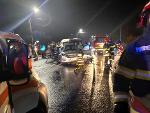The contradictory declarations made over time by the management of the National Company Nuclearelectrica and the Autonomous Administration for Nuclear Activities make us believe that something is rotten with the nuclear reactors in Cernavodă: either the emanated tritium concentration is much higher than it should be, thus jeopardizing the environment, or we already have a large surplus of heavy water, in which case it is not justified to continue production until 2017...
In an interview given in May, the General Manager the National Company Nuclearelectrica, Pompilu Budulan, said in response to questions from the Curierul Naţional, that "units U 1 and 2, which are operational, use heavy water only for technological additions; the amount required is approximately 5 tons per year for a unit."
Two months later, however, the ROMAG Prod management, subordinated to the Autonomous Administration for Nuclear Activities (RAAN), announced, in response to our questions regarding the quantity of heavy water which constitutes state reserve that "according to the CANDU 600-type reactor design and the technical specifications related to nuclear security, it is necessary to have a quantity of heavy water to ensure technological additions throughout the reactors' lifetime (of about 30 years). This amount is estimated by the designer at 12 tons / year / unit.
The contradiction is clear: while Nuclearelectrica claims that the technological additions of a unit require only 5 tons / year, the producer, ROMAG, claims that a two and a half times bigger quantity is needed ... Or, if the Drobeta plant representatives tell the truth, the consequences could be disastrous, or at least should alarm us, because the result would be a radioactive pollution with tritium 230% higher than that allowed for each reactor in part!
According to the famous researcher on tritium issu









